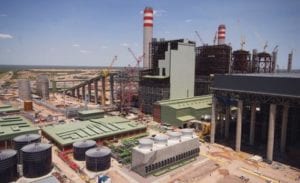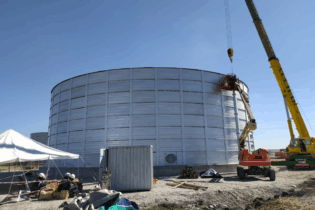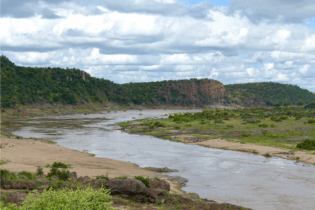Eskom recently received a silver commendation during the Department of Water Affairs 2013 Water Conservation and Water Demand Management Sector Awards. Maryke Foulds speaks to the GM of Water and Environmental Operations at Eskom, Nandha Govender, about the company’s vision of sustainable water management at the utility and how this award validates the work Eskom is doing.
TRAINED AS A mechanical engineer, Govender has spent the past 15 years as a passionate champion of water causes in South Africa. He says: “Part of the vision is to develop sustainable long-term solutions to water supply challenges in South Africa as well as the optimum management of water within Eskom’s operations and facilities. “There are a number of facets to this operation. We have to look at integrating water risks in our short- to long-term business planning and decision-making, with a major focus on water conservation and water demand management initiatives, to reduce Eskom’s water usage by 2030 and improve the water consumption rates to produce a kWh of electricity, while ensuring zero harm and protection of our water resources. Eskom has a major role to play in sustainability functions, and we also focus heavily on water stewardship initiatives. We are participating and collaborating in a number of partnerships with government and the private sector in addressing some of these challenges.” In a water-scarce country that is still very reliant on electricity produced from coal-fired power stations, water issues are critical to not only the functioning of Eskom’s operations, but the broader community and the environment. “One of the biggest challenges facing Eskom is that of water quality. Excess mine water that is not properly treated and discharged, as well as decant from abandoned and ownerless mines, has an impact on water resource quality and contributes to the pollution of our water resources. Poor management and infrastructure problems exacerbate this, and Eskom is left to foot the bill of treatment of poorer quality water it abstracts from various dams and then has to deal with the disposal of the waste residue, eventually translating to the cost of producing electricity. Eskom is working very closely with its coal suppliers to ensure that the mines are compliant with environmental and water licensing conditions and to manage water effectively during operations and closure of these mines. “Several other factors contribute to this situation. When municipal effluent gets into a river, it is normally due to ageing infrastructure and the lack of maintenance of that infrastructure or that the infrastructure is not designed or upgraded timeously to treat the current volumes of effluent. This in turn is exacerbated by a lack of capacity, especially within smaller municipalities. ”Eskom has partnerships in place with its major coal suppliers. “A joint initiative agreement is in place, and we are working together to address these challenges with support from government. Eskom, together with government and the private sector, is currently active in the Effluent and Waste Water Working Group through the South African Strategic Water Partners Network to provide solutions to turning the mine water problems in the Olifants Catchment into a sustainable resource for the benefit of the catchment and its water users. The aim of the working group is to unblock all the constraints and issues in the institutional, regulatory and pricing environment to enable mine water treatment projects to be replicated and, ultimately, upscaled to include a number of adjacent mines. One solution is to introduce regional treatment facilities that benefit more than one mine and also generate sufficient water for sale to other water users in need, with a central disposal facility for the waste produced. The major benefit in a water-scarce catchment such as the Olifants is to offset and minimise the freshwater use by using treated mine water.” Researching and piloting different types of generation technologies and cooling systems to reduce water consumption and usage are an ongoing effort at Eskom. This includes dry-cooling and fluidised-bed combustion (FBC) technology and dry-ashing systems. The new coal-fired power stations under construction, that is, Medupi and Kusile, will feature some of the biggest dry-cooling installations in the world. Dry cooling is the process where the system uses air instead of water to cool the steam exiting a turbine. Dry-cooled systems do not use water and can decrease total power plant water consumption by more than 90%. There are, however, trade-offs to these water savings, namely, higher capital costs and lower thermal efficiencies. In power plants, lower thermal efficiencies mean that more fuel is needed per unit of electricity produced, which can, in turn, lead to higher air pollution and environmental impacts from mining, processing and transporting the fuel.Govender says: “The major advantage is that dry-cooled units can use up to 15 times less water than conventional wet-cooled units. Eskom has made a policy decision to implement dry-cooling technology at all new coal-fired power plant, and thus, Medupi and Kusile will be equipped with dry-cooling technology. We are living in a water-scarce country and the challenge lies in utilising our water resources efficiently through technologies such as dry cooling.”
At the other end of the spectrum lies fluidised-bed combustion (FBC). This is a combustion technology where fluidised beds suspend solid fuels in upward-blowing jets of air during the combustion process. The result is a turbulent mixing of gas and solids. The tumbling action, much like a bubbling fluid, provides effective chemical reactions and heat transfer. FBC is well suited to burning fuels that are difficult to ignite, such as petroleum coke and anthracite, low-quality fuels such as high ash coals and coal mine wastes, and fuels with highly variable heat content, including biomass and fuel mixtures. Govender concurs: “What is exciting about FBC technology is that it also minimises water usage and can use water of a poorer quality. Both these technologies will reduce Eskom’s water and carbon footprint.” Diversifying the energy mix by utilising renewables such as wind and solar, open-cycle gas turbines, and nuclear energy on the coast, as well as importing hydroelectricity, will further reduce Eskom’s water footprint. Eskom is also targeting energy efficiency and conservation to reduce its water footprint. By reducing electricity usage, it also reduces the amount of water used to produce electricity.“We want to bring awareness to our employees, our customers and the public on the importance of water through our Water Conservation and Water Demand Management (WCWDM) Programme and Eskom’s 49M campaign. The WCWDM campaign has as its slogan ‘Saving water to power the nation’, with the main objectives of reducing Eskom’s water consumption to achieve the set targets, reduce Eskom’s reliance on freshwater resources by diversifying its water mix to include treated effluent and mine water, raise awareness of water-related issues within Eskom and change behaviour to save water and electricity.” The main criteria for the WCWDM award ran across three categories, namely:
• reducing water usage in own operations
• innovation, technology and management processes
• research and development around water issues.
Govender continues: “Climate change is of particular concern to Eskom, as this has a direct impact on water resources, and Eskom’s Business Continuity Plans focus on the company’s resilience and response to events such as flooding and drought. Other criteria are broader and include societal and environmental impacts and how these contribute to long-term sustainability and forms part of Eskom’s Water Management Policy and commitments to the UN CEO Water Mandate principles framework, including developing skills and capacity to deal with challenges facing Eskom and the catchments in which it operates.” This is the first time that the Eskom has been given recognition for its work around water management, and this means a tremendous amount on the back of a very difficult year for the parastatal. “We achieved this accolade on the success of our WCWDM Programme. We will continue to focus on partnerships among all sectors and lead work towards the World Economic Forum Water Resources 2030 goal of reducing the water resources gap in South Africa by 2030. Eskom will continue to focus on managing our water resources sustainably by becoming better water stewards,” concludes Govender.








